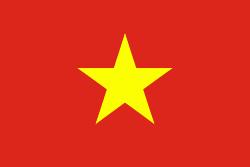Vị Xuyên District (Huyện Vị Xuyên)
Vị Xuyên is a rural district of Hà Giang province in the Northeast region of Vietnam. As of 2019 the district had a population of 110 465. The district covers an area of 1,452 km2. The district capital lies at Vị Xuyên.
A border crossing between Vietnam and China is located in the district at Thanh Thủy. The port of entry on the Chinese side of the border is Tianbao in Malipo county.
Until the Nguyễn dynasty saw the growth of Hà Giang, Vị Xuyên was the largest settlement in the area. Battle of Vi Xuyen is considered more fierce than the Chinese invasion into Vietnam in 1979. This battle lasted approximately four years - from late 1984 to 1989. China PLA was trying to take over Ha Giang's capital - Vi Xuyen, aiming to push into Vietnam's territory by 5 km. But, Vietnamese forces consisting of 9 divisions contained this ambition. The chains of attacks colloquially known as the Battle for Vi Xuyen saw both sides suffering casualties in the thousands. Until now, many missing in action Vietnamese soldiers, both regulars and irregulars have yet to be recorded. Estimation states as many as 3,000 deceased Vietnamese soldiers yet to be accounted for.
A border crossing between Vietnam and China is located in the district at Thanh Thủy. The port of entry on the Chinese side of the border is Tianbao in Malipo county.
Until the Nguyễn dynasty saw the growth of Hà Giang, Vị Xuyên was the largest settlement in the area. Battle of Vi Xuyen is considered more fierce than the Chinese invasion into Vietnam in 1979. This battle lasted approximately four years - from late 1984 to 1989. China PLA was trying to take over Ha Giang's capital - Vi Xuyen, aiming to push into Vietnam's territory by 5 km. But, Vietnamese forces consisting of 9 divisions contained this ambition. The chains of attacks colloquially known as the Battle for Vi Xuyen saw both sides suffering casualties in the thousands. Until now, many missing in action Vietnamese soldiers, both regulars and irregulars have yet to be recorded. Estimation states as many as 3,000 deceased Vietnamese soldiers yet to be accounted for.
Map - Vị Xuyên District (Huyện Vị Xuyên)
Map
Country - Vietnam
 |
 |
| Flag of Vietnam | |
Vietnam was inhabited by the Paleolithic age, with states established in the first millennium BC on the Red River Delta in modern-day northern Vietnam. The Han dynasty annexed Northern and Central Vietnam under Chinese rule from 111 BC, until the first dynasty emerged in 939. Successive monarchical dynasties absorbed Chinese influences through Confucianism and Buddhism, and expanded southward to the Mekong Delta, conquering Champa. The Nguyễn—the last imperial dynasty—surrendered to France in 1883. Following the August Revolution, the nationalist Viet Minh under the leadership of communist revolutionary Ho Chi Minh proclaimed independence from France in 1945.
Currency / Language
| ISO | Currency | Symbol | Significant figures |
|---|---|---|---|
| VND | Vietnamese đồng | ₫ | 0 |
| ISO | Language |
|---|---|
| KM | Central Khmer language |
| ZH | Chinese language |
| EN | English language |
| FR | French language |
| VI | Vietnamese language |















